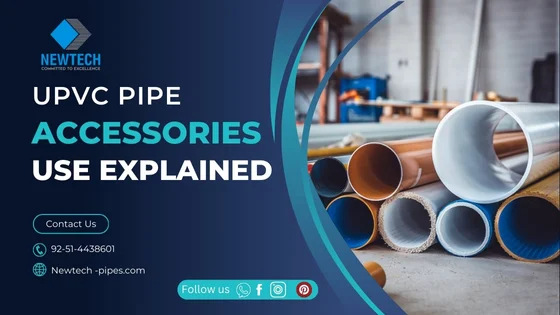In the world of plumbing and piping systems, UPVC (Unplasticized Polyvinyl Chloride) pipes have become a go-to material due to their durability, resistance to corrosion, and cost-effectiveness. However, what truly enhances the functionality and efficiency of a UPVC pipe system are the various accessories available. Whether you’re dealing with water supply, drainage, or irrigation, understanding the role of UPVC pipe accessories can dramatically transform your setup.
In this article, we will dive into the various UPVC pipe accessories, their functions, benefits, and how they can optimize your piping system for a wide range of applications.
Understanding UPVC: What Makes It Ideal for Piping?
What is UPVC?
UPVC, or Unplasticized Polyvinyl Chloride, is a type of plastic that is extremely durable and resistant to chemical erosion. Unlike regular PVC, UPVC is not made flexible by plasticizers, making it more rigid and robust. This makes it an ideal material for piping systems, especially where long-term durability and reliability are required.
Benefits of Using UPVC Pipes
- Corrosion Resistance: UPVC is highly resistant to chemical reactions, which makes it perfect for handling both potable water and waste.
- Cost-Effective: Compared to metal pipes, UPVC pipes and accessories are cheaper, both in terms of material cost and installation.
- Durability: UPVC pipes have a long lifespan, lasting decades with minimal maintenance.
- Lightweight: Their lightweight nature reduces transportation and installation costs.
- Low Maintenance: Due to their resistance to rust, scaling, and corrosion, UPVC pipes require little to no maintenance.
Essential UPVC Pipe Accessories Explained
To maximize the performance of your UPVC piping system, several accessories are available to ensure proper connection, sealing, and functionality. Let’s take a closer look at the most commonly used UPVC pipe accessories:
1. Elbows
Purpose:
Elbows are used to change the direction of the piping system. Available in 90-degree and 45-degree angles, these fittings help direct the flow of liquids or gases without causing pressure loss.
Benefits:
- Helps navigate complex piping layouts.
- Prevents stress on the pipe due to abrupt changes in direction.
2. Tee Connectors
Purpose:
Tee connectors allow pipes to branch into three different directions. These are commonly used when splitting or combining flows in water supply systems.
Benefits:
- Enables efficient flow distribution in piping systems.
- Reduces the number of fittings needed for branching.
3. Couplings and Unions
Purpose:
Couplings and unions are used to join two lengths of pipe together. While couplings offer a permanent connection, unions can be unscrewed, allowing for future disconnection if needed.
Benefits:
- Easy assembly and disassembly for repairs or extensions.
- Ensure leak-proof connections.
4. Reducers
Purpose:
Reducers are used to connect two pipes of different diameters. They help in maintaining a smooth flow between larger and smaller pipes, preventing issues like water hammer or turbulence.
Benefits:
- Facilitates the transition between different pipe sizes.
- Minimizes pressure drops in piping systems.
5. End Caps
Purpose:
End caps are used to close the end of a pipe to stop the flow of liquids or gases. They are often employed during repairs or when a branch of the pipe is no longer needed.
Benefits:
- Seals off pipes securely, preventing leaks.
- Can be removed easily if the system requires further expansion.
6. Valves (Ball and Gate Valves)
Purpose:
Valves control the flow of liquid or gas through the system. Ball valves allow for quick on/off control, while gate valves are better for precise flow regulation.
Benefits:
- Provides control over the flow rate.
- Reduces water hammer issues and ensures safety during repairs or maintenance.
7. Clips and Clamps
Purpose:
Clips and clamps secure the pipes in place, ensuring they remain stable and aligned. They are particularly important for long pipe runs, preventing sagging or shifting.
Benefits:
- Maintains the integrity and alignment of the piping system.
- Reduces the risk of damage due to pipe movement or stress.
8. Gaskets and Seals
Purpose:
Gaskets and seals are used between pipe joints and fittings to ensure a watertight or airtight seal, preventing leaks.
Benefits:
- Guarantees leak-proof connections.
- Extends the lifespan of the piping system by preventing water damage.
9. Adapters (Male and Female)
Purpose:
Adapters connect pipes to various types of fittings, including those made of different materials. They allow UPVC pipes to be integrated into systems with steel, copper, or other pipe types.
Benefits:
- Enhances system versatility.
- Allows for mixed-material piping systems without compromising integrity.
10. Bushings
Purpose:
Bushings reduce the pipe’s diameter at the connection point, enabling different-sized pipes to join smoothly.
Benefits:
- Maintains consistent flow in the system.
- Prevents turbulence caused by abrupt size changes.
How UPVC Pipe Accessories Transform Your Setup
1. Enhanced Functionality
UPVC pipe accessories provide greater control over the flow of liquids and gases, ensuring that your piping system operates smoothly and efficiently. Valves, for example, allow you to regulate flow rates, while reducers help maintain smooth transitions between pipes of different diameters. Accessories like elbows and tees allow for more complex pipe layouts, making it easier to design systems that fit your specific requirements.
2. Improved Durability and Safety
UPVC pipe accessories are designed to withstand harsh environmental conditions, from extreme temperatures to chemical exposure. Using accessories like gaskets and seals ensures leak-proof connections, which reduces the risk of water damage, contamination, or pressure issues in the system.
3. Simplified Installation and Maintenance
UPVC pipe accessories are easy to install and require minimal maintenance. The use of couplings, unions, and adapters simplifies the process of assembling and disassembling pipes, allowing for quick repairs or modifications when needed. Additionally, UPVC accessories are lightweight, making transportation and handling more convenient compared to metal fittings.
4. Cost-Effectiveness
Not only are UPVC pipes and accessories affordable, but their long lifespan and low maintenance requirements make them a cost-effective choice for both residential and commercial installations. With minimal risk of corrosion and damage, you’ll spend less on repairs and replacements over time.
Applications of UPVC Pipe Accessories
1. Residential Plumbing
In residential homes, UPVC pipe accessories are commonly used for water supply and drainage systems. The lightweight nature and corrosion resistance of UPVC pipes make them ideal for both indoor and outdoor applications.
2. Irrigation Systems
For agricultural purposes, UPVC pipe accessories play a crucial role in distributing water evenly across fields. The flexibility and ease of installation make it a popular choice for irrigation setups, particularly in large-scale farming.
3. Commercial and Industrial Applications
UPVC pipe accessories are widely used in commercial buildings and industrial plants for transporting chemicals, waste, and other fluids. Their resistance to a wide range of chemicals ensures longevity even in harsh conditions.
4. Sewage and Drainage Systems
UPVC pipes and their accessories are highly effective in drainage and sewage systems due to their resistance to chemical degradation and their ability to handle heavy loads without cracking or sagging.
Installation Tips for UPVC Pipe Accessories
1. Use the Correct Fittings for Your Application
Each accessory serves a specific purpose, and selecting the right fitting is crucial to the success of your system. For example, using a ball valve instead of a gate valve can lead to improper flow regulation.
2. Ensure Proper Sealing
To prevent leaks, it’s important to use gaskets, seals, and thread tape where necessary. Ensure that all joints are properly tightened and secured.
3. Allow for Flexibility
Although UPVC pipes are rigid, the right accessories can provide flexibility where needed. Using elbows and flexible couplings helps to reduce stress on the pipes and prevent cracking or breaking over time.
4. Regular Inspection and Maintenance
While UPVC systems are low maintenance, it’s important to periodically check the connections and fittings for signs of wear, particularly in areas prone to high pressure or chemical exposure.
UPVC vs Other Piping Materials: Why Accessories Matter
1. UPVC vs. PVC
While both UPVC and PVC pipes share similar properties, UPVC is more rigid due to the absence of plasticizers. This rigidity, combined with the right accessories, offers greater durability for systems exposed to pressure or corrosive substances.
2. UPVC vs. Metal Pipes
Metal pipes are prone to rust and corrosion, making them less durable than UPVC. Additionally, UPVC is easier to install and maintain, especially when combined with lightweight accessories.
3. UPVC vs. HDPE
HDPE pipes are more flexible than UPVC, but UPVC has better chemical resistance. The accessories available for UPVC piping systems provide greater control over flow and system design, making them more versatile for various applications
Conclusion: Elevate Your Setup with UPVC Pipe Accessories
UPVC pipe accessories are more than just add-ons; they are essential components that can dramatically enhance the efficiency, durability, and functionality of your piping system. Whether you’re working on a residential plumbing project or a large-scale industrial installation, using the right UPVC pipe accessories can help you create a system that is both reliable and cost-effective for the long term. By understanding their applications and benefits, you can transform your setup and ensure optimal performance for years to come.
FAQs on UPVC Pipe Accessories
Q1: What are UPVC pipe accessories used for?
A: UPVC pipe accessories are used to enhance pipe connections, control flow, and provide stability in plumbing systems.
Q2: Why are UPVC pipe accessories important?
A: They improve the durability, efficiency, and versatility of your piping setup, making systems easier to install and maintain.
Q3: What are common UPVC pipe accessories?
A: Common UPVC pipe accessories include elbows, tees, valves, reducers, couplings, and adapters.
Q4: How do UPVC valves work?
A: UPVC valves control the flow of liquids or gases through the piping system, allowing for precise flow regulation or shut-off.
Q5: Are UPVC accessories durable?
A: Yes, UPVC accessories are highly durable, resistant to chemicals, and have a long lifespan, making them suitable for various applications.
Q6: Can UPVC accessories be used in industrial settings?
A: Yes, UPVC accessories are commonly used in industrial applications due to their resistance to corrosion and chemicals.
Recent Posts
- Transform Your Setup: UPVC Pipe Accessories Use Explained
- What Does MDPE Pipe Mean? Understanding Its Uses and Benefits
- HDPE Pipe Life Expectancy Explained: Myths vs Facts
- Upkeep for uPVC Pipe Insulation: Maintenance & Care Tips
- UPVC Pipe Heat Resistance: What You


